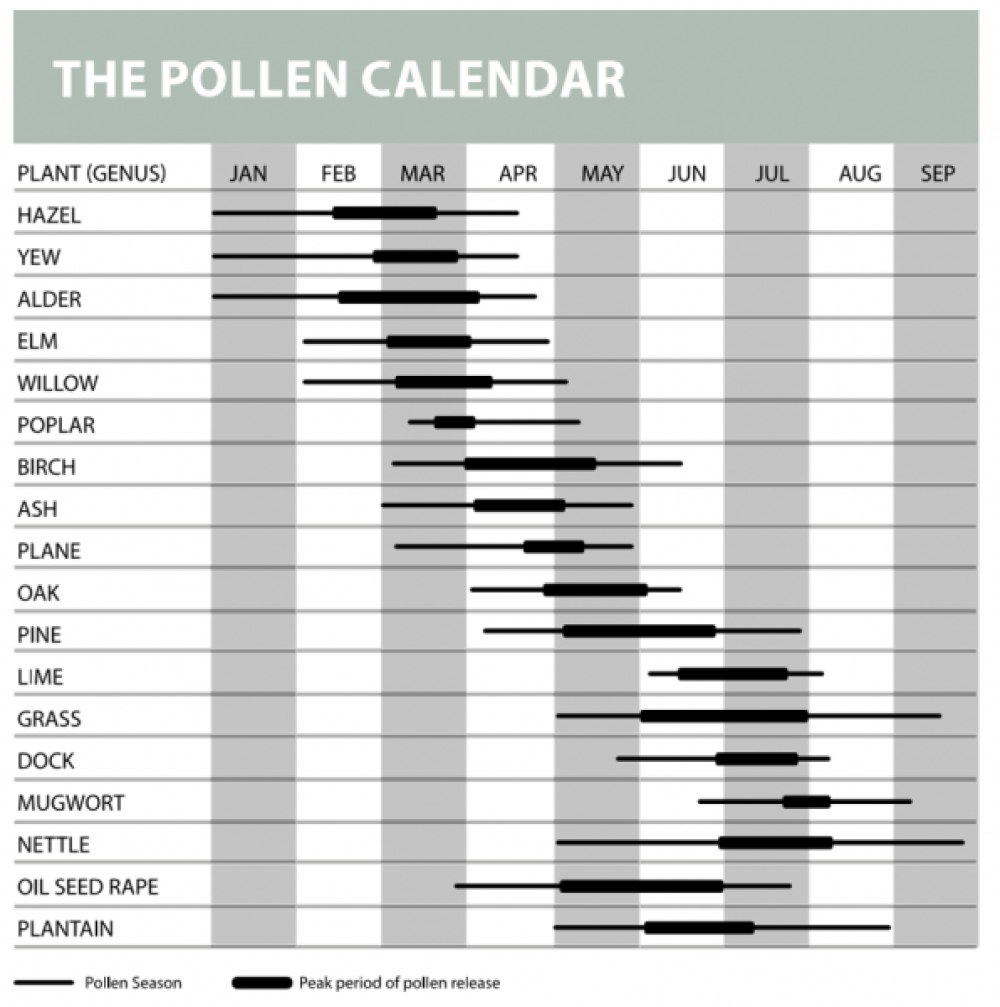
Low Allergy Planting
Low allergy gardening
If you’re one of the one in four of the UK population who suffers from hay fever, your enjoyment of a garden can be seriously spoiled by an allergic reaction to pollen. Symptoms can vary from a runny nose, itchy eyes and sneezing through to anaphylactic shock in the worst cases. You can avoid or lessen your hay fever by the plants you choose to grow in your garden.
What is pollen?
Hay fever is an allergic reaction to airborne grains of pollen released by plants. One of the ways plants reproduce is by the transfer of pollen from the male parts of one flower to the female parts of another flower. Some plants are pollinated by insects while others are pollinated by the wind. Insects are much more efficient at pollination so insect pollinated plants only need to produce a small amount of pollen. Wind pollination is much less efficient: plants that rely on wind pollination have to produce huge amounts of pollen to stand a chance of it reaching the right flowers.
Some plants have male and female parts on the same plant so the pollen doesn’t need to travel far. Other plants only have either male or female parts so the male plants need to release large amounts of pollen to reach the female plants.
How do I choose the right plants?
As a rule of thumb, if you want a low allergy garden, avoid wind pollinated plants such as grasses and avoid plants that are male only. Many trees and shrubs will be either male or female so you should check the plant details before buying. Many street trees in public spaces have been chosen to be male only to reduce the amount of mess they create from pollen and fallen flowers but this increases the risk of an allergic reaction.
There are some general visual clues for indication of wind or insect pollinated flowers, although there are always exceptions!
Wind pollinated plants tend to have small petals, often brown or dull green with no scent as there is no need to attract insects. They produce large amounts of light smooth pollen.
Insect pollinated plants tend to have brightly coloured sweetly scented flowers with moderate or low amounts of heavy, sticky or spiky pollen designed to stick to insects.
You could also go for plants with sterile flowers such as double flowers but these don’t support pollinators. If you really want a plant that produces lots of pollen, locate it away from doors, paths and patios. If you work out from which direction the wind normally comes into your garden, you could plant a dense hedge to trap pollen. More planting and less hard surfaces will help too as hard surfaces keep the pollen airborne whereas planting helps trap pollen.
If you want to work out which plant in your garden is causing your allergic reaction, make a note of when you get hay fever. Each plant has a predictable flowering season. Trees are the first to flower in January, finishing in late April. Grasses flower in late spring and weeds in summer. Within these groups, there are differences e.g. hazel trees flower before birch trees.
If you find that you sneeze, cough, have an itchy, runny nose and eyes at certain times of the year, you may have seasonal allergies to a specific species. Have a look at the pollen calendar below to find out what might be causing your hay fever.


Here are some plants that have low amounts of pollen or are insect-pollinated:
- Abelia
- Ajuga
- Alchemilla
- Aloysia
- Antirrhinum
- Aquilegia
- Arbutus
- Astrantia
- Begonia
- Camellia sinensis
- Choisya ternata
- Clematis
- Citrus x limon
- Coleonema
- Cotoneaster
- Delphinium
- Digitalis
- Dicentra
- Eryngium
- Gaultheria
- Geum
- Genista
- Geranium
- Hebe
- Hedera
- Hemerocallis
- Heuchera
- Hosta
- Impatiens
- Iris
- Lamium
- Leptospermum
- Lobelia
- Nigella
- Papaver
- Parthenocissus
- Penstemon
- Plumbago
- Prunus
- Punica
- Pyrus salicifolia
- Rosemarinus
- Salvia
- Scabiosa
- Thalictrum
- Thymus
- Trachelospermum Jasminoides
- Viburnum
- Vinca
- Viola
- Vitexagnus castus
- Vitis
Do be aware that even if you choose low allergy plants in your garden, you should expect airborne pollen from neighbouring gardens to blow into your garden.
Where to get more information:
Allergy UK www.allergyuk.org
Asthma UK www.asthma.org.uk
Royal College of Pathologists www.rcpath.org
Quex Plant Nursery www.allergyfriendlyplants.co.uk/
- Author
- Clive Meredeen
- Photographer
- Clive Meredeen
- Editor
- Mark Cummings
